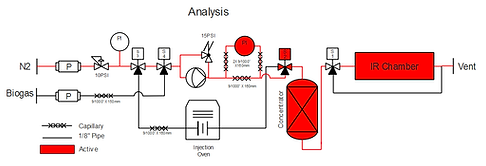
Siloxane Monitoring
How the monitor works

The STS Siloxane Monitor is designed to quantify siloxanes in biogas using NDIR (non dispersive infrared)
technology. Siloxanes are particularly difficult to measure due to their "sticky" and persistent nature. Part of the
challenge of making accurate measurements is ensuring that the measurement cell and concentrator are not
contaminated after taking a reading. To alleviate this, the monitor is purged with nitrogen to remove any residues,
and the concentrator is heated to drive off any residue which may not have been released, leaving it clean for
the next cycle. The monitor records one reading per hour under normal conditions- approx 15mins are the sampling
phase, 10 minutes the measurement phase, and the rest is cleaning and purging ready for the next sample.
The column is then heated which releases the siloxanes from the media and they are carried by a N2 carrier gas into the measurement cell. The cell comprises a Infrared source, filters and an pyroelectric detector mounted behind specialised windows. As the carrier gas passes through the cell the siloxanes cause absorbance of the IR signal so the received signal by the detector falls and produces and equivalent voltage drop. This is recorded and processed to produce a mass of material which when calculated with the sample volume produces a reading in mg/m3.

The monitor produces a total siloxane reading which is the sum of the various species from L3 through to D6. The unit is usually calibrated using either D4 or D5 dependent on the site as these tend to form 80%+ of the siloxanes seen and are also the most damaging being the larger molecules.





CONTROL CARBON
FILTER COSTS

ONLINE & ONSITE
DATA ACCESS
LOW MAINTENANCE
DESIGN

PRE-PACKAGED
READY FOR INSTALL

